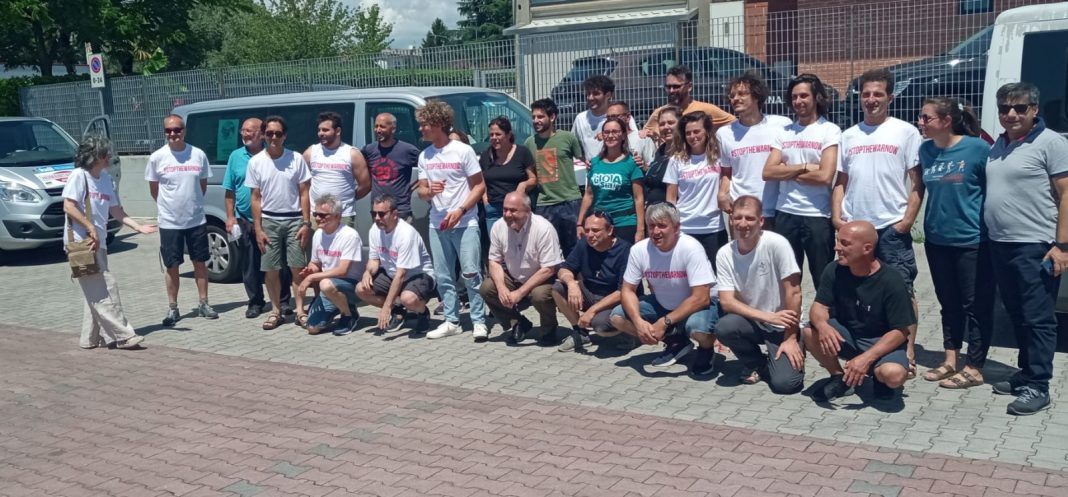by Emanuele Giordana
While Italy sends weapons to the Ukranian army involved in the fight agaisnt Russian invaders, there are at least four fronts of the Italian pacifist movement looking towards Ukraine. They give signs of exceptional vitality as well as, unfortunately and in honour of an old mantra that sounds like a condemnation, of the fact that the movement struggles to find a single voice despite the fact that the path is common. In fact, everyone thinks along the same lines: promoting dialogue, not ceding to the weapons spiral, non-violence, pressure on governments, involvement of the civil society. But everyone goes their own way. We will try to give an account of this, albeit with all the limitations of a knowledge, so vast is this movement that is very little told, necessarily limited and perhaps even deficient.
Perhaps the most interesting aspect seems to be the one concerning the StoptheWarNow coalition, born thanks above all to the drive of the Associazione Papa Giovanni XXIII (Pope John XXIII Association), also known for its commitment abroad as ‘Operation Dove’. In a very short time, the coalition has agglutinated very different formations: large and small, purely humanitarian, trade union, secular and Catholic. The coalition has already organised two caravans in Lviv and Odessa, transporting tons of basic necessities and often bringing back people (in the hundreds) with frailties. It has opened a base in Odessa and plans to open two more permanent ones in Kiev and Lviv in order to structure relationship-building work that is currently in its infancy. A third caravan is planned for the end of August. Different projects are moving within it, such as, for example, the one that Un ponte per is building with the Ukrainian associations in Kiev or the adhesion to the national demonstration called by Europe for Peace for 23 July for an international peace conference.
A second initiative is called MEAN, and was explained by Angelo Moretti and Marco Bentivogli as: ‘an extraordinary and unprecedented bridge of dialogue between Italian and Ukrainian active citizenship has been built’ (extract from La Repubblica). From this, stemmed the project of a ‘European Nonviolent Action Movement’, with the aim of connecting European, Ukrainian and Russian civil societies. The idea is for a ‘choral and civic’ action that will be transformed on 11 July into a ‘mass trip to Kiev’ so that ‘leaders of Italian and Ukrainian civil society will speak together to talk about possible peace’. And again: ‘Peace building is a value to be cultivated every day… Peace is not a positioning flag. It cannot be instrumental’. Sacrosanct speeches – perhaps a little emphatic – even if the number of marchers planned has realistically been reduced from the initial 5,000 to a wiser ‘limit of 150 activists, as martial law provides’ (and also the capacity of the air-raid shelters). What is surprising is that a link has not been established with StoptheWarNow, if only because it was the first initiative and above all because it has gathered 176 associations in its varied coalition to date. You now have important experience to build on. There was an exchange of letters but in the end no agreement.
There is another very significant absence in the StoptheWarNow coalition and it is that of the Tavola della Pace or, to put it another way, the coordination of the Perugia-Assisi March, whose numbers and importance we all know. Perugia-Assisi is Italy’s largest (and recurring) civil society march for peace: an institution in itself, in the pacifist scenario of the country. Such an absence is heavy and perhaps difficult to understand for those who march every year from Perugia to Assisi. And it is precisely to this people of ‘mavericks’, who do not belong to any association, organisation, church or trade union, that the finale of this brief summary must be dedicated. In following the caravans and in various meetings around Italy on the war, we have not only registered a desire (especially among the young and very young) to participate ‘physically’ in concrete actions, but we have touched with our own hands more than one reality, made up of perhaps four young people who, having rented a minibus and filled it with pasta and peeled tomatoes, set off for Kiev. With great enthusiasm (as in the days of the Balkan war) and scraping together funds here and there and often networking with their own municipalities. But without leadership or an agenda that goes beyond humanitarian solidarity. Without, in short, a political path that requires time, research, organisation. Let us make our own the comment of a great witness of Italian pacifism: ‘The peace movement is the best part of Italian society,’ says Lisa Clark, ‘but if you don’t start together, you don’t build anything.
Cover image: participants to the caravan, set to deliver humanitarian materials, travelling from Italy to Odessa in late June 2022.
























